ECS P67H2-A Review: A visit back to Lucid's Hydra
by Ian Cutress on July 21, 2011 9:00 AM EST- Posted in
- Motherboards
- Lucid
- P67
- ECS
LAN Speed Test
LAN Speed Test is a freeware program designed for testing the network connection between two PCs on a home network. The speed of the transfer is limited by the lowest common denominator on the network, so if you have gigabit Ethernet capable computers but a 100 Mbit capable router, you are limited to 100 Mbit transfer. Note that this is really a formality – if a network port is rated at 1 Gbps, then chances are that it will hit at least 90+% of this value. The main test here is CPU usage, and how much is offloaded by the controller. For this test, we use LAN Speed Test to transfer a 1000 MB file across a home network with a 100 Mbps lowest common speed to the same machine each time, in a read/write scenario. CPU usage is taken as a visual max/average from task manager.
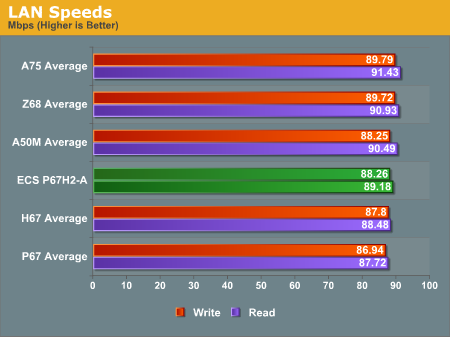
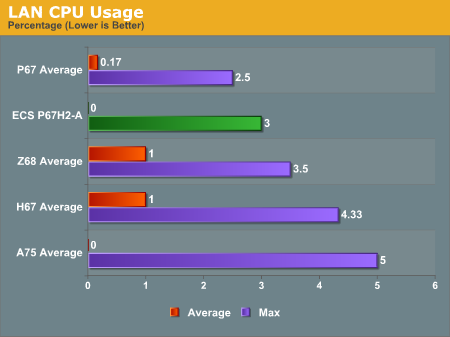
The P67H2-A falls relatively in the middle compared to other boards we've tested in terms of network performance, and below the P67 average overall in peak CPU usage.
USB Speed
For this benchmark, we run CrystalDiskMark to determine the ideal sequential read and write speeds for the USB port using our 64GB Patriot SuperSpeed USB 3.0 drive. Then we transfer a set size of files from the SSD to the USB drive, and monitor the time taken to transfer. The files transferred are a 1.52 GB set of 2867 files across 320 folders – 95% of these files are small typical website files, and the rest (90% of the size) are the videos used in the Sorenson Squeeze test.
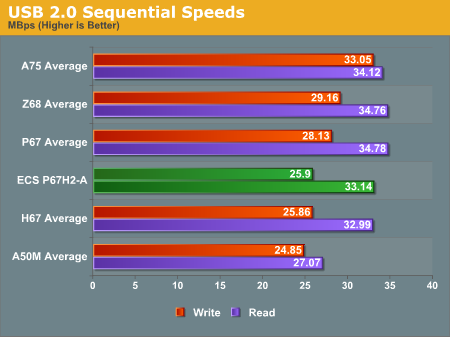
USB 2.0 write speed is fairly lacking on the ECS board in terms of sequentials, losing 3 MBps to the P67 average.
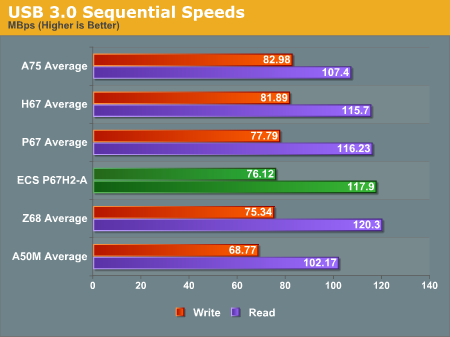
Also here, the USB 3.0 sequential write speeds are below the P67 average.
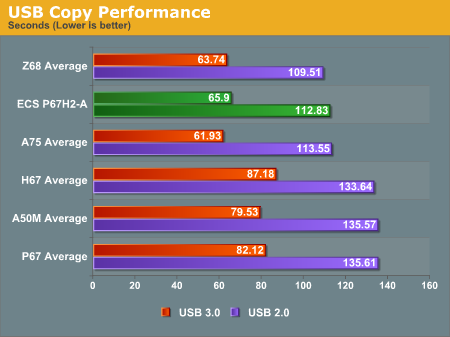
In terms of real world copy performance however, it looks like the ECS driver does the job compared to almost every other board tested.
SATA Testing
We also use CrystalDiskMark for SATA port testing. The operating system is installed on the Micron RealSSD C300, which is rated at 355 MB/s read and 215 MB/s write, and the sequential test is run at the 5 x 1000 MB level. This test probes the efficiency of the data delivery system between the chipset and the drive, or in the case of additional SATA ports provided by a third party controller, the efficiency between the controller, the chipset and the drive.
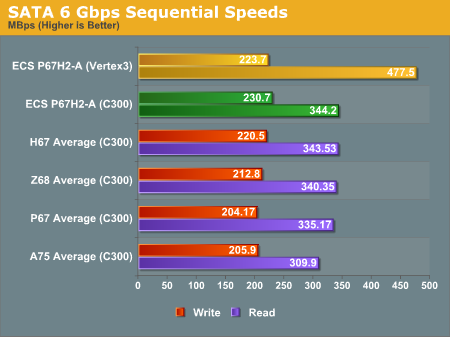
At peak speeds with the C300, the ECS board is one of the best we've tested on the SATA 6 Gbps PCH ports.
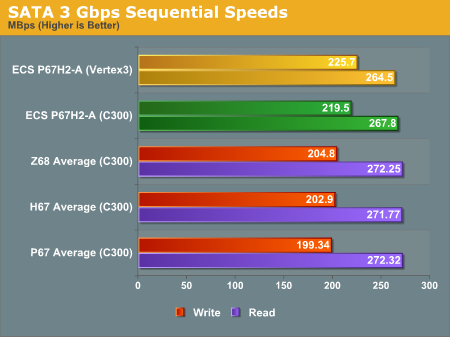
This is also echoed in the SATA 3 Gbps results.
DPC Latency
Deferred Procedure Call latency is a way in which Windows handles interrupt servicing. In order to wait for a processor to acknowledge the request, the system will queue all interrupt requests by priority. Critical interrupts will be handled as soon as possible, whereas lesser priority requests, such as audio, will be further down the line. So if the audio device requires data, it will have to wait until the request is processed before the buffer is filled. If the device drivers of higher priority components in a system are poorly implemented, this can cause delays in request scheduling and process time, resulting in an empty audio buffer – this leads to characteristic audible pauses, pops and clicks. Having a bigger buffer and correctly implemented system drivers obviously helps in this regard. The DPC latency checker measures how much time is processing DPCs from driver invocation – the lower the value will result in better audio transfer at smaller buffer sizes. Results are measured in microseconds and taken as the peak latency while cycling through a series of short HD videos - under 500 microseconds usually gets the green light, but the lower the better.

The ECS board is one of the best we've had in terms of DPC latency.










22 Comments
View All Comments
MWilliamson - Thursday, July 21, 2011 - link
An excellent review Ian; I'm impressed by how many combinations you tested under Hydra. While I'm currently not looking to build another system, I have found Hydra to be an interesting concept, and I'm waiting for it to mature to the point where it is valid for all configurations.What I wished to comment on though, was your comment in the Gaming Benchmarks:
"Metro 2033 is the Crysis of the DirectX 11 world (or at least until Crysis 2 is released)..."
Crysis 2 HAS been released, and has been available since April. Granted at the time of release it did not support DirectX 11, due largely in part to it being launched simultaenously on PC and consoles, a recent patch (released June 27th) has added its DirectX 11 feature set, and another patch increased the texture quality for PC gamers, both of which are actually optional, free upgrades. The most recent version, 1.9, also added a demo level which can be run via the in-game console; personally I have no experience with that side of things, since I played through for the storyline, but it is there, and I'd imagine its something you could add to your benchmarking suite, should it suit whatever your requirements are.
IanCutress - Thursday, July 21, 2011 - link
Many thanks on the update :) Not had much time to play games recently, but at some point I want to update the GPU drivers in my reviews also. Updating GPU drivers essentially removes all previous GPU results, so it might be worth having a look at the games I test as well at the same time.Ian
MWilliamson - Thursday, July 21, 2011 - link
You're most welcome, I had thought that was a possibility :)Igen - Thursday, July 21, 2011 - link
Hard to tell from the pics, but are those heatsinks riveted on? Would make mods/repairs difficult.DanNeely - Thursday, July 21, 2011 - link
The southbridge sink has what look like plastic fasteners; I'd assume they're pushpins of some sort. The moftset/etc sinks are harder too tell because of the angle and not being perfectly in focus, but if you look at the fastener in the lower right on the 5th pic the recessed area shows two indents that look like they're in the right spots to be part of a philips head which is otherwise out of sight. A high resolution vertical image/bottom image would really help.Uritziel - Friday, July 22, 2011 - link
MOFTSET lol! I'm going to start saying that :)Death666Angel - Thursday, July 21, 2011 - link
The green color of the ECS mainboard bars in the graphs for gaming makes little sense here, because then we don't know which resolution was used, as the resolution is identified as the colors. Though of course the higher resolution has most likely the lower fps numbers, it still looks odd. :-)Good review though!
HangFire - Thursday, July 21, 2011 - link
You got 3? Wow. My old ECS C2D board had one (two if you count the CPU).ECS has really moved up over the years.
fausto412 - Thursday, July 21, 2011 - link
this solution is junk.dhiiir - Friday, July 22, 2011 - link
I believe that the best motherboard can be ruined with a terrible BIOS or UEFI. UEFI is pretty cool, but if you can't make a good text only implementation, how the hell are you going to make a passable GUI? I'm perfectly happy with a well designed text based UEFI, but I will admit that as much time as I spend with BIOSs and UEFIs, Asus' slick GUI system is clearly in a class by itself. If I were new to the game, I would want something like that on my first build. There just isn't an excuse for terrible BIOS/UEFIs in the year 2011.I like online shopping,but don't know where have a good store to buy . I have a friend said that a shop is very good. -.www.upsfashion.com- I went. Really good. Things are cheap, fashion,. Owner has a good attitude. I am really happy to buy things there.